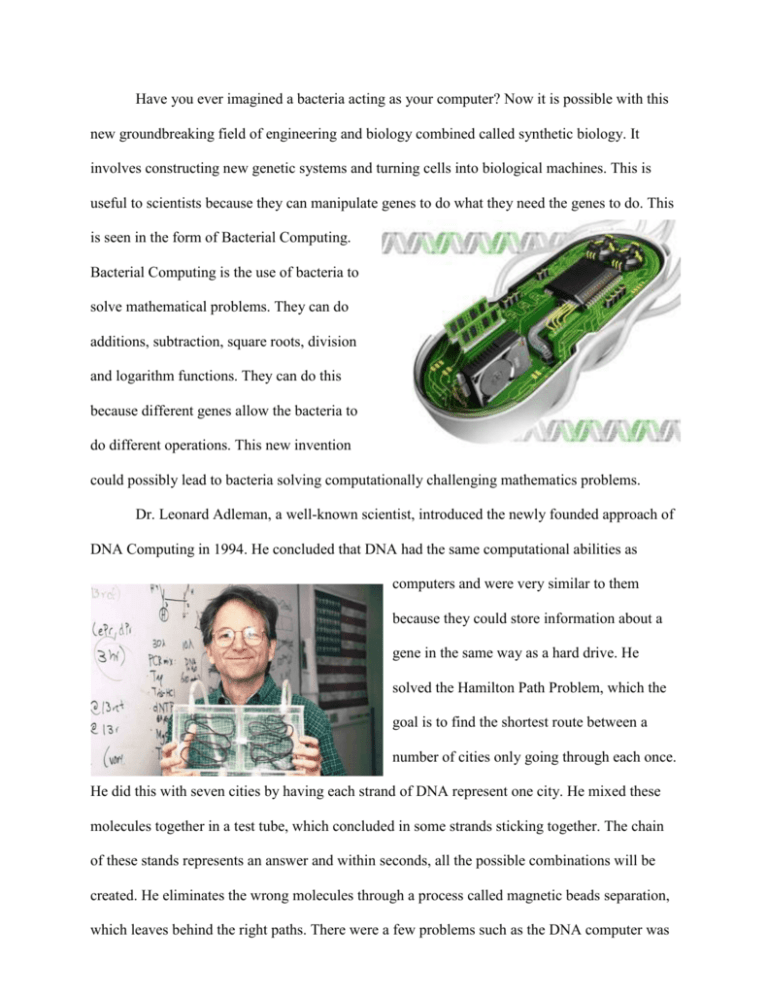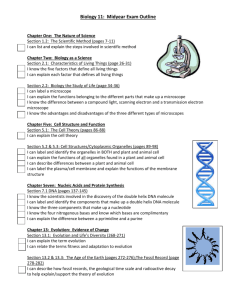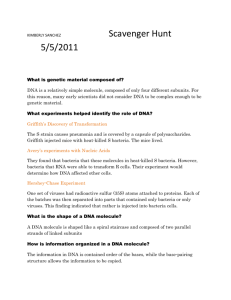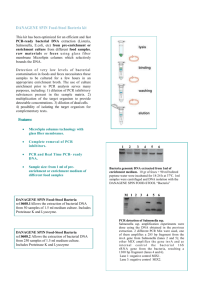Bacterial Computing Research Project - BLI-Research
advertisement

Have you ever imagined a bacteria acting as your computer? Now it is possible with this new groundbreaking field of engineering and biology combined called synthetic biology. It involves constructing new genetic systems and turning cells into biological machines. This is useful to scientists because they can manipulate genes to do what they need the genes to do. This is seen in the form of Bacterial Computing. Bacterial Computing is the use of bacteria to solve mathematical problems. They can do additions, subtraction, square roots, division and logarithm functions. They can do this because different genes allow the bacteria to do different operations. This new invention could possibly lead to bacteria solving computationally challenging mathematics problems. Dr. Leonard Adleman, a well-known scientist, introduced the newly founded approach of DNA Computing in 1994. He concluded that DNA had the same computational abilities as computers and were very similar to them because they could store information about a gene in the same way as a hard drive. He solved the Hamilton Path Problem, which the goal is to find the shortest route between a number of cities only going through each once. He did this with seven cities by having each strand of DNA represent one city. He mixed these molecules together in a test tube, which concluded in some strands sticking together. The chain of these stands represents an answer and within seconds, all the possible combinations will be created. He eliminates the wrong molecules through a process called magnetic beads separation, which leaves behind the right paths. There were a few problems such as the DNA computer was slow and needed human assistance at all steps. Now scientists have figured out how to use logic gates in bacteria and make certain circuits give a certain math operation. DNA computing is a form of Biocomputing that uses DNA, instead of the typical silicon based computer technologies. The process of Biocomputing uses systems of biologically derived molecules such as proteins and DNA, to perform computational operations. Another type of Biocomputing is called Bacterial computing, which is manipulating the DNA of bacteria to do computational functions. Scientists are now able to use bacteria instead of the silicon-based chips in computers. This is the same process as DNA computing instead we use bacteria. This can store data, transfer data and receive data along with mathematical operations. In the future, we could possibly have computers made of bacteria. With the knowledge, synthetic biologists now have of bacterial computing; they can do mathematical operations such as logarithm functions and other simple math functions. Synthetic Biologists have come up with new logic gates such as the AND gate, NOR gate and the NAND gate. These gates gave the biologists the power to control the bacteria even more because now they can control the function to start or stop if both, one or none of the chemicals are there. With this new knowledge of logic gates, they were then able to create the circuits to perform the different logarithms. They use a low-copynumber plasmid and a high-copy-number plasmid. The low-copy-plasmid generates positive feedback by comprising of promoters, which generate transcriptions factors that bind to the promoters and alleviate saturation between inducers and transcription factors. The highcopy-number plasmid comprises of promoters that bind and shunt away the transcription factors from the LCP and reduce saturation between the transcription factors and DNA. AraC, a transcriptional activator on the LCP circuit, induces arabinose, which then activates the promoter on the HCP circuit. This produced mCherry, which is used as a tracer or a marker when attached to the fluids and it also produces gfp. This circuit is used to do the function In(1+x). The scientists decided to use analog circuits, which can take in multiple inputs rather than the digital circuits that can only take in two kinds of value. In addition to sensing a molecule, analog circuits can also tell its concentration. The way they calculated the output of a function was they recorded the concentration of the resulting mCherry in each circuit and the amount of the input molecules, and created a graph. This graph represented the graph of the function, which they could use to get answer to any number inputted to the function within the range of the graph. The researchers modified the circuits to expand the range of the function, resulting in more outputs. For other functions such as In(x), scientists figured out that they needed to change the circuit to do the function that they wanted. They had to change everything such as the promoters, transcription factors and the proteins. By changing these promoters, transcription factors and proteins, they were able to get different functions. For each function, it has its own circuit which is different from the others. Changing the promoter or the transcription factor, changes the way the molecules react and the rate in which the molecules are produced. The researchers’ main goal was not to use bacteria for mathematical calculations, because we already have very powerful computers and calculators to do that, but rather it is a proof-ofconcept. This shows just what one of many complicated analog circuits can do. This proves that the researchers could control the bacteria to be able to get the bacteria to do mathematical calculations. The researchers hope, having this new knowledge of bacterial computing, is to now be able to make new remedies for cancer. They would also like to make a computer made out of bacteria, which would be faster and more efficient compared to the computers we have now. These are just some of the ideas they have for the future. The ideas are endless with the information they have now.









